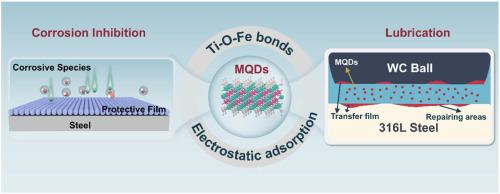Ti3C2Tx quantum dots achieve superior corrosion inhibition and lubrication via forming Ti–O–Fe coordination bonds: Experimental verification and computational investigation
IF 11.6
2区 材料科学
Q1 CHEMISTRY, PHYSICAL
引用次数: 0
Abstract
Metal corrosion and mechanical wear result in a serious decrease in the service life of marine engineering equipment. Carbon-based quantum dots (CDs) are often used as corrosion inhibitors or lubricants due to their ease of functionalization and quantum size effect. However, the protection efficiency of CDs is limited by weak adsorption capacity, and additional doping of heteroatoms such as N and S is usually needed to enhance the adsorption. Here, Ti3C2Tx quantum dots (MQDs) were synthesized by using two-dimensional Ti3C2Tx sheets containing abundant functional groups on the surface as precursors. The corrosion inhibition efficiency of MQDs with a concentration of 400 mg L−1 reached 94.2 %, and the coefficient of friction and wear rate were reduced by 67.6 % and 83.2 %, respectively, compared with the single NaCl solution. Surface analysis showed that MQDs blocked the penetration of corrosive species via forming a protective film on the steel surface through the formation of Ti–O–Fe coordination bonds. Notably, the thickness of protective film was affected by the pH of solution, reaching a maximum thickness of 215 nm at the NaCl solution with a pH of 7. Finally, density functional theory and molecular dynamics simulations were utilized to deeply reveal the adsorption mechanism of MQDs. This study provides new insights into the role of MQDs as dual-functional additives, which is of great significance in promoting the development of multifunctional marine engineering protective materials.

Ti3C2Tx量子点通过形成Ti-O-Fe配位键实现优异的缓蚀和润滑:实验验证和计算研究
金属腐蚀和机械磨损导致海洋工程设备的使用寿命严重下降。碳基量子点(CDs)由于其易于官能化和量子尺寸效应而经常被用作缓蚀剂或润滑剂。但由于cd的吸附能力较弱,限制了cd的保护效率,通常需要额外掺杂N、S等杂原子来增强吸附。本文以表面含有丰富官能团的二维Ti3C2Tx片为前驱体,合成了Ti3C2Tx量子点。当浓度为400 mg L−1时,MQDs的缓蚀效率达到94.2%,摩擦系数和磨损率分别比单一NaCl溶液降低67.6%和83.2%。表面分析表明,MQDs通过形成Ti-O-Fe配位键在钢表面形成保护膜,阻止了腐蚀物质的渗透。值得注意的是,保护膜的厚度受溶液pH的影响,在pH为7的NaCl溶液中,保护膜的最大厚度为215 nm。最后,利用密度泛函理论和分子动力学模拟深入揭示了MQDs的吸附机理。本研究对mqd作为双功能添加剂的作用提供了新的认识,对促进多功能海洋工程防护材料的发展具有重要意义。
本文章由计算机程序翻译,如有差异,请以英文原文为准。
求助全文
约1分钟内获得全文
求助全文
来源期刊

Carbon
工程技术-材料科学:综合
CiteScore
20.80
自引率
7.30%
发文量
0
审稿时长
23 days
期刊介绍:
The journal Carbon is an international multidisciplinary forum for communicating scientific advances in the field of carbon materials. It reports new findings related to the formation, structure, properties, behaviors, and technological applications of carbons. Carbons are a broad class of ordered or disordered solid phases composed primarily of elemental carbon, including but not limited to carbon black, carbon fibers and filaments, carbon nanotubes, diamond and diamond-like carbon, fullerenes, glassy carbon, graphite, graphene, graphene-oxide, porous carbons, pyrolytic carbon, and other sp2 and non-sp2 hybridized carbon systems. Carbon is the companion title to the open access journal Carbon Trends. Relevant application areas for carbon materials include biology and medicine, catalysis, electronic, optoelectronic, spintronic, high-frequency, and photonic devices, energy storage and conversion systems, environmental applications and water treatment, smart materials and systems, and structural and thermal applications.
 求助内容:
求助内容: 应助结果提醒方式:
应助结果提醒方式:


